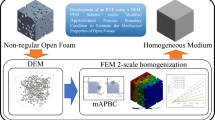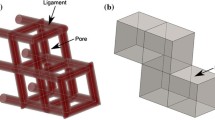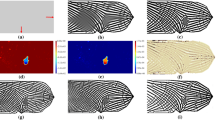Abstract
The pursuit of more representative numerical models for open-cell metallic foams requires the computation of volume and percentage porosity of geometries containing randomly distributed interconnected pores, which is one of the main characteristics that determines its mechanical properties. From a mathematical standpoint, the analytical definition of foam geometries forms a three-dimensional non-convex set. It is known that the volume computation of n-dimensional polytopes and sets is a P-hard problem. A common way to approach this problem is using the Monte Carlo techniques; however, efforts are oriented toward the treatment of convex polytopes and polyhedrons. In this article, the Direct Monte Carlo Simulation (DMCS) is used to compute the percentage porosity of three-dimensional non-convex sets. A single-thread Python code was implemented, and tests were run to estimate the percentage porosity of three-dimensional open-cell porous geometries. Measurements of percentage porosity and runtime requirements over cubical and cylindrical geometries containing from 100 to 4000 overlapping spherical pores showed high accuracy and consistency in non-convex three-dimensional sets, while the proposed algorithm achieved a significant reduction in computing time with respect to the currently available method. In the same manner, results from the proposed algorithm were compared with a similar software available, showing a gain in both performance time and accuracy.








Similar content being viewed by others
Explore related subjects
Discover the latest articles and news from researchers in related subjects, suggested using machine learning.References
Banhart J (2001) Manufacture, characterisation and application of cellular metals and metal foams. Prog Mater Sci 46(6):559–632. https://doi.org/10.1016/S0079-6425(00)00002-5
Ashby MF, Evans A, Fleck NA, Gibson LJ, Hutchinson JW, Wadley HNG, Delale F (2001) Metal foams: a design guide. Appl Mech Rev 54:B105. https://doi.org/10.1016/s0261-3069(01)00049-8
Hasan A (2010) An improved model for FE modeling and simulation of closed cell Al-alloy foams. Adv Mater Sci Eng 1:12. https://doi.org/10.1155/2010/567390
Geers MG, Kouznetsova VG, Brekelmans WA (2010) Multi-scale computational homogenization: trends and challenges. J Comput Appl Math 234(7):2175–2182. https://doi.org/10.1016/j.cam.2009.08.077
Kanit T, Forest S, Galliet I, Mouroury V, Jeulin D (2003) Determination of the size of the representative volume element for random composites: statistical and numerical approach. Int J Solids Struct 40(13–14):3647–3679. https://doi.org/10.1016/S0020-7683(03)00143-4
Kari S, Berger H, Rodriguez-Ramos R, Gabbert U (2007) Computational evaluation of effective material properties of composites reinforced by randomly distributed spherical particles. Compos Struct 77:223–231. https://doi.org/10.1016/j.compstruct.2005.07.003
Stefanou G, Savvas D, Papadrakakis M (2017) Stochastic finite element analysis of composite structures based on mesoscale random fields of material properties. Comput Methods Appl Mech Eng 326:319–337. https://doi.org/10.1016/j.cma.2017.08.002
Cadena JH, Alfonso I, Ramírez JH, Rodriguez-Iglesias V, Figueroa IA, Aguilar C (2014) Improvement of FEA estimations for compression behavior of Mg foams based on experimental observations. Comput Mater Sci 91:359–363. https://doi.org/10.1016/j.commatsci.2014.04.065
Pérez L, Lascano S, Aguilar C, Domancic D, Alfonso I (2015) Simplified fractal FEA model for the estimation of the Young’s modulus of Ti foams obtained by powder metallurgy. Mater Des 83:276–283. https://doi.org/10.1016/j.matdes.2015.06.038
Pérez L, Lascano S, Aguilar C, Estay D, Messner U, Figueroa IA, Alfonso I (2015) DEM–FEA estimation of pores arrangement effect on the compressive Young’s modulus for Mg foams. Comput Mater Sci 110:281–286. https://doi.org/10.1016/j.commatsci.2015.08.042
Pérez L, Mercado R, Alfonso I (2017) Young’s modulus estimation for CNT reinforced metallic foams obtained using different space holder particles. Compos Struct 168:26–32. https://doi.org/10.1016/j.compstruct.2017.02.017
Pérez L, Cabrera I, Santiago AA, Vargas J, Beltrán A, Alfonso I (2018) Effect of the Al–CNT interlayer on the tensile elastic modulus of Al matrix composites with random dispersion of CNTs. J Braz Soc Mech Sci Eng 40(11):550. https://doi.org/10.1007/s40430-018-1473-1
Janssen H (2013) Monte-Carlo based uncertainty analysis: sampling efficiency and sampling convergence. Reliab Eng Syst Saf 109:123–132. https://doi.org/10.1016/j.ress.2012.08.003
Till MS, Ullmann GM (2009) McVol—A program for calculating protein volumes and identifying cavities by a Monte Carlo algorithm. J Mol Model 16(3):419–429. https://doi.org/10.1007/s000894-009-0541-y
Cundall P, Stack O (1979) A discrete numerical model for granular assemblies. Geotechnique 29(1):47–65. https://doi.org/10.1680/geot.1979.29.1.47
Torres Y, Pavón JJ, Nieto I, Rodriguez JA (2011) Conventional powder metallurgy process and characterization of porous titanium for biomedical applications. Metal Mater Trans B 42(4):891–900. https://doi.org/10.1007/s11663-011-9521-6
Jha N, Mondal DP, Majumdar JD, Badkul A, Khane AK (2013) Highly porous open cell Ti-foam using NaCl as temporary space holder through powder metallurgy route. Mater Des 47:810–819. https://doi.org/10.1016/j.matdes.2013.01.005
Li K, Gao XL, Subhash G (2005) Effect of cell shape and cell wall thickness variations on the elastic properties of two-dimensional cellular solids. Int J Solids Struct 42(5–6):1777–1795. https://doi.org/10.1016/j.ijsolstr.2004.08.005
Nitka M, Combe G, Dascalu C, Desrues J (2011) Two-scale modeling of granular materials: a DEM-FEM approach. Granular Matter 13(3):277–281. https://doi.org/10.1007/s10035-011-0255-6
Soro N, Brassart L, Chen Y, Veidt M, Attar H, Dargusch MS (2018) Finite element analysis of porous commercially pure titanium for biomedical implant application. Mater Sci Eng A 725:43–50. https://doi.org/10.1016/j.msea.2018.04.009
Schröder J, Balzani D, Brands D (2010) Approximation of random microstructures by periodic statistically similar RVE based on linear-path functions. Arch Appl Mech 81(7):975–997. https://doi.org/10.1007/s00419-010-0462-3
Smit R, Brekelmans W, Meijer H (1998) Prediction of the mechanical behavior of nonlinear heterogeneous systems by multi-level finite element modeling. Comput Methods Appl Mech Eng 155(1–2):181–192. https://doi.org/10.1016/s0045-7825(97)00139-4
Báez-Pimiento S, Hernández-Rojas M, Palomar-Pardavé M (2015) Processing and characterization of open-cell aluminum foams obtained through infiltration process. Proc Mater Sci 9:54–61. https://doi.org/10.1016/j.mspro.2015.04.007
Orbulov IN (2013) Metal matrix syntactic foams produced by pressure infiltration—the effect of infiltration parameters. Mater Sci Eng A 583:11–19. https://doi.org/10.1016/j.msea.2013.06.066
Cleary PW (2005) A multiscale method for including fine particle effects in DEM models of grinding mills. Miner Eng 84:88–99. https://doi.org/10.1016/j.mineng.2015.10.008
Coetzee C (2017) Review: calibration of the discrete element method. Powder Technol 310:104–142. https://doi.org/10.1016/j.powtec.2017.01.015
Boemer D, Ponthot J-P (2016) DEM modeling of ball mills with experimental validation: influence of contact parameters on charge motion and power draw. Comput Part Mech 4(1):53–67. https://doi.org/10.1007/s40571-016-0125-4
Kloss C, Goniva C, Hager A, Amberger S, Pirker S (2012) Models, algorithms and validation for opensource DEM and CFD-DEM. Prog Comput Fluid Dyn Int J 12(2/3):140–152. https://doi.org/10.1504/pcfd.2012.047457
ASTM (2018) Standard testing methods of compression testing of metallic materials in room temperature. ASTM International. https://doi.org/10.1520/f0067-13r17
Dyer ME, Frieze AM (1988) On the complexity of computing the volume of a polyhedron. SIAM J Comput. https://doi.org/10.1137/0217060
LG Khachiyan (1988) On the complexity of computing the volume of a polytope. Izvestia Ajad. Nauk SSSR, Engineering Cybertics. 216–217
Khachiyan LG (1989) The problem of calculating the volume of a polyhedron is enumerably hard. Russ Math Surv 44(3):199–200. https://doi.org/10.1070/rm1989v044n03abeh002136
Chazelle BM (1981) Convex decompositions of polyhedra. In: Proceedings of the thirteenth annual ACM symposium on Theory of computing, Milwaukee. https://doi.org/10.1145/800076.802459
Bueler B, Enge A, Fukuda K (2000) Exact volume computation for polytopes: a practical study. Polytopes—combinatorics and computation. Springer Basel AG, Basel, pp 131–154
Ge C, Ma F (2015) A fast and practical method to estimate volumes of convex polytopes. In: International Workshop of Frontiers in Algorithms, 2015. https://doi.org/10.1007/978-3-319-19647-3_6
Liu S, Zhang J, Zhu B (2007) Volume computation using a direct Monte Carlo method. Comput Comb Banff. https://doi.org/10.1007/978-3-540-73545-8_21
Emiris I, Fisikopoulos V (2014) Efficient random-walk methods for approximation polytope volume. Proceedings of the thirtieth annual symposium on Computational geometry, Kyoto. https://doi.org/10.1145/2582112.2582133
Lien JM, Amato N (2007) Approximate convex decomposition of polyhedra. In: Proceedings of the 2007 ACM symposium on Solid and physical modeling, Beijing, China, 2007. https://doi.org/10.1145/1236246.1236265
Morris C, Stark R (2015) Finite mathematics: models and applications. John Wiley & Sons, Hoboken
Suadhakar Y, Wall W (2013) Quadrature schemes for arbitrary convex/concave volumes and integration of weak form in enriched partition of unity methods. Comput Methods Appl Mech Eng 258:39–54. https://doi.org/10.1016/j.cma.2013.01.007
Cazals F, Kanhere H, Loriot S (2011) Computing the volume of a union of balls: a certified algorithm. ACM Trans Math Softw 38(1):1–20. https://doi.org/10.1145/2049662.2049665
Kaas R, Buhrman JM (1980) Mean, median and mode in binomial distributions. Stat Neerl 34(1):13–18. https://doi.org/10.1111/j.1467-9574.1980.tb00681.x
Canavos GC (1984) Applied probability and statistical methods. Little, Brown
Ballio F, Guadagnini A (2004) Convergence assessment of numerical Monte Carlo simulations in groundwater hydrology. Water Resour Res. https://doi.org/10.1029/2003wr002876
Gilman M (1968) A brief survey of stopping rules for Monte Carlo. In: Second conference on applications of simulations, New York, NY
Author information
Authors and Affiliations
Corresponding author
Additional information
Publisher's Note
Springer Nature remains neutral with regard to jurisdictional claims in published maps and institutional affiliations.
Appendices
Appendix A
In this appendix, the complete Python code script is presented. This code runs in single core configuration allowing to estimate the porosity of cylindrical- or cubic-shaped foam geometries containing randomly distributed spherical pores when a complete analytical description of it (i.e. overall dimensions and pores location and dimension) is given in a JavaScript script file. The code uses Eq. 15 to average the results obtained by a series of Monte Carlo simulations, based on an LHS strategy, according Eqs. 5, 6, 7, and 8. The code will iterate until two established criteria are met, which are a minimum number of iteration and a maximum standard error, according to Eq. 18. This code requires the user to provide the filename with its extension as system argument (e.g., Cube_100_1.js). The path to the file is assumed to be the current work directory



Appendix B
In this appendix, more detailed information regarding the computed percentage porosity for the data set obtained by means of the proposed algorithm and McVol after 20 independent runs are presented in Table 2.
Appendix C
In this appendix, more detailed information regarding the computed runtimes for the data set for the proposed algorithm and McVol after 20 independent runs are presented in Table 3.
Rights and permissions
About this article
Cite this article
Campillo, M., Pérez, P., Daher, J. et al. Percentage porosity computation of three-dimensional non-convex porous geometries using the direct Monte Carlo simulation. Engineering with Computers 37, 951–973 (2021). https://doi.org/10.1007/s00366-019-00866-2
Received:
Accepted:
Published:
Issue Date:
DOI: https://doi.org/10.1007/s00366-019-00866-2




